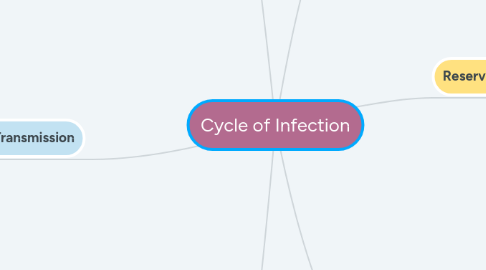
1. Portal of Exit
1.1. How a pathogen leaves a reservoir
1.1.1. Blood
1.1.1.1. During a trauma situation radiologic technologists could encounter blood or other bodily fluids that can carry a pathogen, therefore it is very important to wear gloves and protect and clean the equipment used.
1.1.2. Respiratory secretions
1.1.2.1. Mucus
1.1.2.2. Saliva
1.1.3. From gastrointestinal tract
1.1.3.1. Feces
1.1.4. From urinary tract
1.1.4.1. Urine
2. Mode of Transmission
2.1. Direct
2.1.1. Droplet
2.1.1.1. Diseases that are transferred by infected droplets touching the eyes, nose, or mouth.
2.1.1.1.1. Coughing
2.1.1.1.2. Sneezing
2.1.1.1.3. Talking
2.1.1.1.4. Medical procedures
2.1.1.2. Droplets are too large to be airborne for very long
2.1.1.3. Use PPE such as face masks and goggles to reduce droplet contact
2.1.2. Direct Contact
2.1.2.1. Physical touch between an infected person and a susceptible person
2.1.2.1.1. Touch
2.1.2.1.2. Kissing
2.1.2.1.3. Sexual contact
2.1.2.1.4. Contact with oral secretions
2.1.2.1.5. Contact with body lesions
2.1.2.2. Requires close contact and usually occurs between close friends and family and those in the same household
2.1.2.3. Diseases spread by direct contact are unable to survive for long periods of time away from a host
2.2. Indirect
2.2.1. Airborne
2.2.1.1. Residue from evaporated droplets and dust particles that contain microorganisms remain suspended in the air for extended periods of time
2.2.1.2. Must be capable of surviving outside of the body for long periods of time and resistant to drying
2.2.1.3. Airborne transmission allows for organisms to enter the upper and lower respiratory tracts
2.2.1.3.1. Limited numbers of diseases are capable such as Tuberculosis, Chickenpox, and Measles
2.2.2. Vehicle Borne
2.2.2.1. Fomite
2.2.2.1.1. Inanimate objects and materials that are likely to carry infection (frequent touch surfaces)
2.2.3. Vector Borne
2.2.3.1. Mechanical
2.2.3.1.1. Animate things that pick up pathogens on the outside of their bodies and transmit them to others through physical contact
2.2.3.2. Biological
2.2.3.2.1. Animate things that transmit pathogens by breaking the skin and leaving saliva, eggs, or feces inside
3. Portal of Entry
3.1. Ways in which pathogens get into the body
3.1.1. Mucous membrane
3.1.2. Non-intact skin (wounds)
3.1.3. Respiratory tract
3.1.3.1. Nose
3.1.3.2. Mouth
3.1.4. Gastrointestinal tract
3.1.4.1. Bodily excretions such as feces
3.1.5. Genitourinary tract
3.1.5.1. Urine and other excretions
3.1.6. Blood
3.2. Pathogens tend to enter a body in the same way it had exited the reservoir (pathogens from someone's sneeze enter through another person's nose)
4. Pathogen
4.1. Bacteria
4.2. Viruses
4.2.1. Intracellular parasites
4.2.1.1. Can only reproduce inside of a living cell
4.3. Fungi
4.4. Parasites
4.5. Depends on the amount, potency, ability to enter the body, ability to survive in the body, and the susceptibility of the host
5. Reservoir
5.1. Any person, animal, arthropod, plant, soil, or substance that an infectious agent normally lives in or multiples on
5.1.1. Animate
5.1.1.1. People
5.1.1.2. Insects
5.1.1.3. Animals
5.1.2. Inanimate
5.1.2.1. Soil
5.1.2.2. Water
5.1.2.3. Food
5.1.2.4. Feces
5.1.2.5. Intravenous fluid
5.1.2.6. Equipment
5.1.2.6.1. Radiology departments have a mass amount of equipment that patients and employees touch several times a day. It is important to clean these inanimate reservoirs so that it does not spread pathogens.
5.2. The infectious agent depends on the reservoir to survive and reproduce so that it can be transmitted to a host
6. Susceptible Host
6.1. An individual who is at risk of infection
6.1.1. Immune-compromised people
6.1.1.1. HIV or AIDS
6.1.1.2. Rheumatoid arthritis
6.1.1.3. Diabetes
6.1.1.4. Cancer
6.1.1.5. Organ or bone transplant
6.1.1.6. Older population
6.1.1.7. Smokers
6.1.1.8. Autoimmune diseases
6.1.2. Recently ill people
6.2. Infection does not immediately occur when a pathogen enters someone's body, it depends on the host, the agent, and the environment
6.2.1. Presence of natural barriers
6.2.2. Functional state of the immune system
6.2.3. Whether there is an invasive device or not

